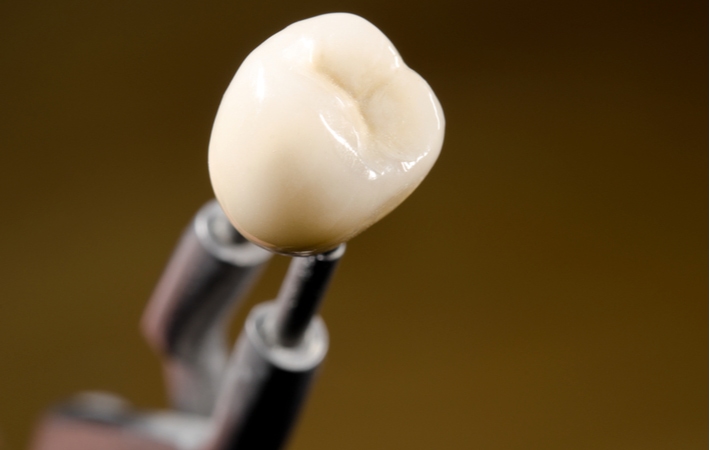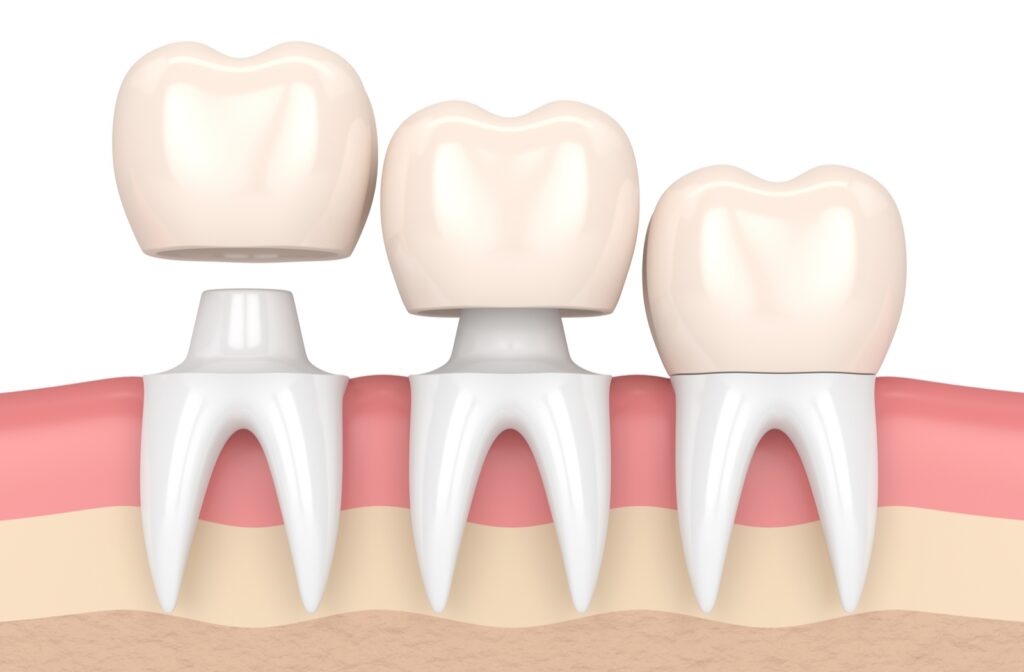A Crown for Your Tooth
A crown, like the name implies, sits on the head or top of your tooth. However, unlike a crown indicating royalty, a crown for your tooth is more like a knight’s helmet. The dental procedure is performed when your tooth or teeth are damaged or degraded.
Crowns are a type of cosmetic dentistry. Despite the term cosmetic, the procedure isn’t performed simply to make your teeth look better. Instead, crowns and bridges are also added to support the structure or integrity of your tooth or teeth.
During your regular comprehensive oral exam, the health and structure of your teeth are assessed. If your tooth is missing its natural protective layer or your oral health is compromised, your dentist might recommend a crown.
What Is Tooth Decay?
Your teeth have layers, some protecting your teeth and others supporting your oral health. The outer layer, enamel, is the hardest substance in your body. It covers the softer inner layers of your teeth so you can keep on chewing.
However, although enamel is tough, it can be eroded. If untreated, the damage can cause tooth decay.
Tooth decay has five stages to indicate the level of decay or damage. From stage 2 onward, your tooth or teeth experience enamel decay, which breaks down the protective layer. As a result, you may develop a cavity, a small hole in your tooth.
Cavities and enamel erosion can indicate worsening tooth decay caused by plaque and tartar.
What Is Plaque and Tartar?
Plaque is a biofilm, a sticky coating containing bacteria and leftovers from your lunch. Most plaque is easily removed by your oral hygiene routine, such as brushing and flossing. Unfortunately, when it accumulates, it hardens into dental tartar.
When the bacteria, proteins, and sugars mixed in your mouth buildup, they can form tartar (dental calculus). The harder substance forms above or below your gumline and can cause enamel erosion.
Symptoms of Enamel Erosion
Enamel erosion can damage your teeth and cause various symptoms, including:
- Pain
- Shiny spots
- Rough edges
- Discolouration
- Fractured teeth
- Cracks or chips
- Tooth sensitivity
- Tooth decay (cavities)

It’s Time for A Crown
After assessing your tooth health at a dental exam, your dentist will decide how best to treat your cavity or tooth decay. Some options include a filling, crown, or a root canal. The less erosion or damage, the more likely you’ll need a less invasive procedure. Small holes will only require a dental filling.
However, if the deterioration has changed your tooth’s shape or removing decay alters tooth shape, you may need a crown. A crown or a cap is an artificial covering used to restore shape, strength, and function.
As a crown is attached to an existing tooth, there are cases when tooth decay is too extensive. If a tooth must be removed or can’t support a crown, your dentist may decide a dental bridge is a better choice.
Improving Your Smile
Although tooth decay is a common reason for a crown, it’s also an option for improving tooth appearance. A crown adds strength and shape. If a tooth is uneven, edged, short, or needs a minor adjustment, a crown can cover the flaw.
Talk to your dentist if you’re hiding your smile because of one or two teeth. Braces aren’t the only choice for a healthier smile.
Crown Materials
A crown is typically natural in appearance, as it should blend in with your smile. However, there are many materials used for crowns, such as:
- Metal
- Ceramic
- Zirconia
- Porcelain
- Composite resin
- Combination of materials
One metal choice you might be familiar with is gold. Gold has been used in dental repairs for over 4,000 years. Although gold crowns are a highly durable choice, they can cost more. There are also some side effects, such as allergic reactions.
The most popular choice for appearance is porcelain, but it can be more vulnerable to wear over time. Combination crowns, such as porcelain-fused-to-metal, can combine the strengths of multiple materials.
Your dentist will decide which type of crown is best for your oral health. However, if you have allergies, make sure to mention them, so your dentist has all the information.
How Cosmetic Dentistry Protects Your Smile
dentistry is more than a perfect smile, but we know looking good can feel good. If you have symptoms of tooth decay or want to improve your tooth appearance, you might benefit from a crown.
Dental crowns are available in multiple types and materials. Your dentist can assess your teeth and determine the best options. Visit Palermo Village Dental for a dental checkup to learn more about your oral health.Book an appointment today!




